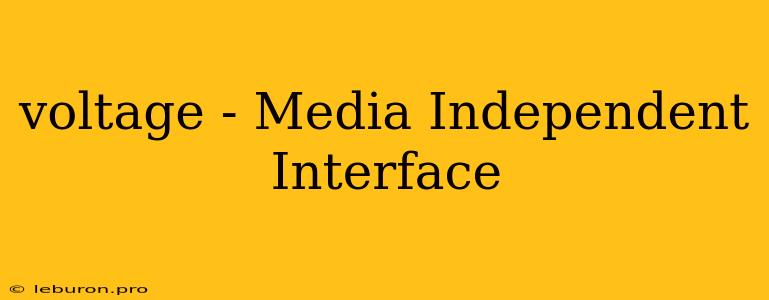Navigating the World of Voltage with Media Independent Interface (MII)
The world of electronics is built upon the fundamental concept of voltage. This electrical potential difference drives the flow of current, enabling the operation of everything from simple circuits to complex computers. However, the intricacies of voltage transmission and management can be a daunting challenge, particularly when dealing with the complexities of modern communication systems. One key element in addressing this challenge is the Media Independent Interface (MII), a standardized interface that ensures seamless communication between physical layer devices and the higher layers of the network stack.
Understanding the MII: A Bridge Between Layers
The MII serves as a crucial link between the physical layer, responsible for transmitting data signals over a physical medium like copper or fiber optic cable, and the higher layers of the network stack, such as the data link layer and the network layer. This interface effectively decouples the physical layer from the higher layers, allowing for flexibility and adaptability in communication system design.
How Does the MII Work?
The MII operates by defining a specific set of signals and protocols for data transmission. It essentially acts as a translator, converting the data signals from the physical layer into a format that can be understood by the higher layers, and vice versa. This standardized interface ensures compatibility between different physical layer devices and network components, allowing for interoperability and seamless communication across diverse communication systems.
Key Features of the MII:
- Standardized Interface: The MII utilizes a predefined set of signals and protocols, ensuring compatibility between different physical layer devices and network components.
- Data Rate Flexibility: The MII can handle a wide range of data rates, accommodating the diverse needs of different network applications.
- Signal Integrity: The MII employs robust signaling techniques and transmission protocols to maintain signal integrity, minimizing data corruption and ensuring reliable communication.
- Reduced Complexity: By abstracting the physical layer complexities, the MII simplifies the design and implementation of communication systems, reducing development time and effort.
MII in Action: Practical Applications
The MII finds widespread application in various communication systems, including:
- Ethernet Networks: The MII is a core component of Ethernet networks, enabling the connection of network interface cards (NICs) to switches and routers.
- Fiber Channel Systems: The MII is used in Fiber Channel systems, facilitating high-speed data transfer over fiber optic cables.
- Wireless Networks: While not directly used in wireless networks, the principles of the MII are applied in the design of wireless interfaces, ensuring seamless communication between devices and wireless access points.
Benefits of Using the MII
The MII offers several significant advantages for network designers and developers:
- Interoperability: The standardized nature of the MII ensures compatibility between different physical layer devices, promoting interoperability and flexibility in network design.
- Modularity: The MII allows for easy integration of different physical layer components, facilitating modular network architectures.
- Scalability: The MII can support various data rates and communication protocols, enabling the scaling of network infrastructure to meet evolving demands.
- Cost-Effectiveness: The standardized interface reduces the cost of development and manufacturing, as components can be easily shared and reused across different networks.
The Future of MII and Voltage
As communication technology continues to evolve, the MII remains a critical component in ensuring seamless data flow and efficient operation. New advancements in voltage management and signaling techniques will continue to enhance the capabilities of the MII, enabling higher data rates, improved signal integrity, and greater flexibility in future network architectures. The role of the MII in bridging the gap between the physical layer and higher network layers will continue to be crucial in the future development of robust, scalable, and reliable communication systems.
In conclusion, the Media Independent Interface (MII) plays a vital role in enabling efficient and reliable communication in modern electronic systems. Its ability to decouple physical layer complexities from higher layers of the network stack provides a powerful tool for building interoperable, modular, and scalable communication networks. As technology advances, the MII will undoubtedly continue to evolve, leveraging new advancements in voltage management and signaling techniques to drive innovation and improve the performance of future communication systems.
